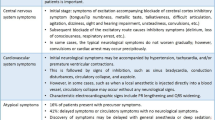Abstract
In recent years an increasing number of drug fatalities with blood concentrations of lidocaine up to 33 μg/ ml or of the tetracaine metabolite 4-n-butylaminobenzoic acid up to 8.6 μg/ml was observed in Berlin. These high concentrations originated from the use of the local anaesthetics as adulterants in cocaine, heroin or cocaine-heroin mixtures. The comparison of the lidocaine concentrations with that of 38 fatalities with a different cause of death, in which the drug was used as an antiarrhythmic during resuscitation attempts (0.1–24 μg/ml) and with literature data on local anaesthesia accidents leads to the conclusion that in a substantial number of drug cases an intoxication by the local anaesthetics alone or in combination with other drugs is sufficient to death. In seven cases the concentration of 4-n-butylaminobenzoic acid was above 4 μg/ml (corresponding to > 5.5 μg/ml tetracaine). These values confirm the stronger toxicity of tetracaine in comparison to lidocaine known from the literature. As a reason for the particularly high danger of the use of local anaesthetics as adulterants in illicit drug mixtures, it must be assumed that after application of normal amounts by intravenous bolus injection, very high blood concentrations appear immediately in the heart and CNS, which cause death by central paralysis and blockade of the cardiac conduction system.
Zusammenfassung
In Berlin traten in den letzten Jahren vermehrt Drogentodesfälle mit Blutkonzentrationen an Lidocain bis 33 μg/ml oder dem Tetracainmetaboliten 4-n-Butylaminobenzoesäure bis 8,6 μg/ml auf, die auf die Injektion der Lokalanästhetika als Beimischungen zu Cocain, Heroin oder Cocain-Heroin-Zubereitungen zurückzuführen sind. Der Vergleich der in 46 Fällen festgestellten Lidocainkonzentrationen mit denen von 38 andersartigen Todesfällen, bei denen dieser Wirkstoff als Antiarrhythmikum bei Reanimationsversuchen diente (0,1 bis 24 μg/ml), und mit Literaturdaten von Anästhesieunfällen ergab, daß in vielen dieser Fälle hochtoxische bis komatös-letale Werte erreicht wurden, die allein oder in Kombination mit anderen Betäubungsmitteln den Todeseintritt durch Lähmung des ZNS oder Blockade des kardialen Reizleitungssystems erklären. In 7 Fällen wurde eine 4-n-Butylaminobenzoesäure-Konzentration oberhalb 4 μg/ml (entspr. > 5,5 μg/ml Tetracain) festgestellt. Hier kann die Tetracainapplikation als todesursächlich angesehen werden. Diese Werte bestätigen die aus der Literatur bekannte höhere systemische Toxizität des Tetracains im Vergleich zum Lidocain.
Similar content being viewed by others
Author information
Authors and Affiliations
Additional information
Eingegangen: 28. Dezember 1998 / Angenommen: 16. Februar 1999
Rights and permissions
About this article
Cite this article
Herre, S., Pragst, F., Rießelmann, B. et al. Zur toxikologischen Bewertung der Lokalanästhetika Lidocain und Tetracain bei Drogentodesfällen. Rechtsmedizin 9, 174–183 (1999). https://doi.org/10.1007/s001940050105
Issue Date:
DOI: https://doi.org/10.1007/s001940050105




